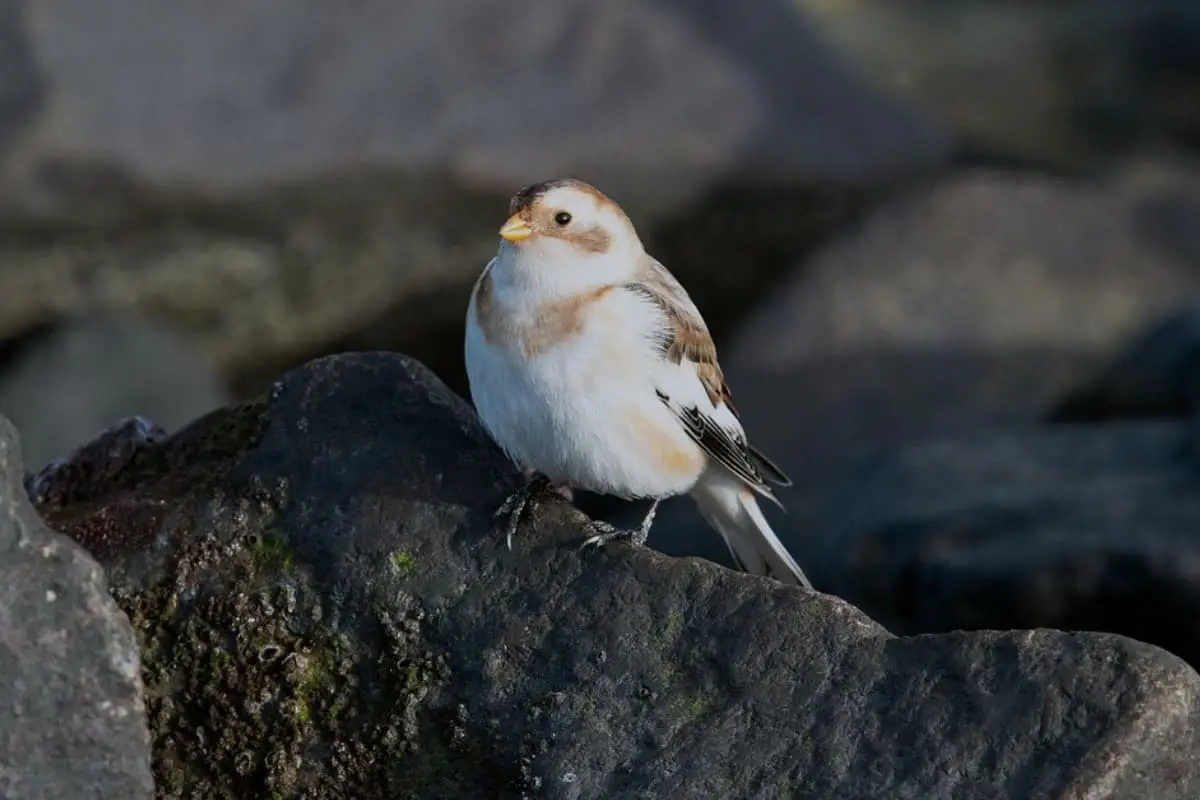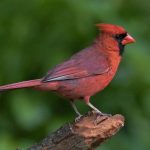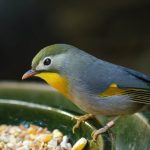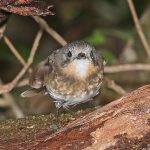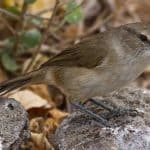Common Name: Snow Bunting
Scientific Name: (Plectrophenax nivalis)| Size | Diet | Range in Hawaii | Status in Hawaii |
|---|---|---|---|
| 6 in. - 7 in. | seeds and insects | Unknown | Least Concern |
The Snow Bunting (Plectrophenax nivalis) is a delightful bird species with a unique appearance. Its white and brown plumage and playful behavior make it a charming sight in its natural habitat.
Although it is not a native species to Hawaii, Snow Buntings have been spotted occasionally on the islands as non-breeding visitors or vagrants, providing an exciting opportunity for bird enthusiasts. This article will explore the fascinating world of the Snow Bunting, including its unexpected presence in Hawaii.
Snow Bunting
Appearance
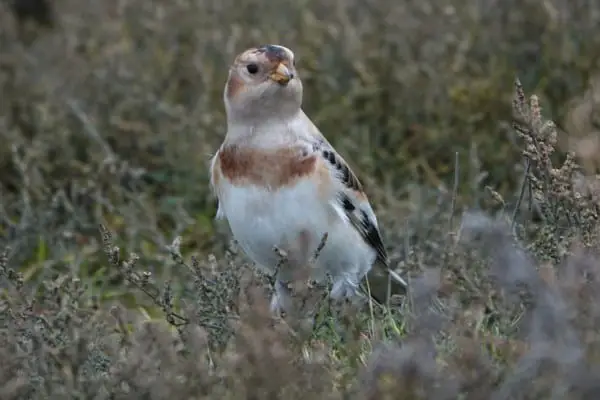
Snow Buntings are small to medium-sized birds with distinct plumage. On average, they measure around 6 to 7 inches (15 to 18 centimeters) in length.
During the breeding season, male Snow Buntings display a striking appearance. They have a mostly white plumage with black wingtips, creating a stark contrast.
The wings also feature a broad white wingbar. Their heads are adorned with a black crown and throat, while their cheeks and necks are white. The bill and legs are typically black.
Female Snow Buntings have a more subdued appearance. Their plumage is brownish-gray, providing better camouflage in their arctic breeding habitats.
They also have white wingbars and black wingtips, although the contrast is less pronounced compared to males.
Outside of the breeding season, both males and females undergo a molt and acquire a more uniform brownish-gray plumage, resembling the appearance of the female. This molted plumage helps them blend into their winter surroundings.
Diet
The diet of Snow Buntings primarily consists of seeds and insects. During the breeding season, when insects are more abundant, their diet is more insect-oriented. They feed on a variety of small invertebrates such as beetles, flies, caterpillars, spiders, and their larvae.
Outside of the breeding season, Snow Buntings rely heavily on seeds as their main food source. They consume a wide range of seeds, including those from grasses, sedges, and various herbaceous plants. They are particularly adept at foraging for seeds in open fields, meadows, and tundra areas where such food resources are abundant.
Snow Buntings have a specialized bill adapted for seed consumption. Their short, stout bills are ideal for cracking open seeds and extracting the nutritious kernel inside.
These birds often forage in flocks, searching the ground for seeds and insects. They may hop or walk on the ground while actively feeding, occasionally taking flight to move to new foraging areas.
Nesting
Snow Buntings are ground-nesting birds that typically breed in the arctic and subarctic regions of the Northern Hemisphere. Here is a short description of their nesting behavior:
Snow Buntings construct their nests on the ground, usually in protected locations such as rocky crevices, tussocks, or in the shelter of low vegetation. The female takes the primary responsibility for nest building, using a combination of grasses, moss, twigs, and other plant materials.
The nest is cup-shaped and lined with softer materials like feathers, plant down, and hair. This lining provides insulation and comfort for the eggs and the developing young.
Females lay a clutch of 4 to 6 eggs, which are usually pale bluish-green with brown speckles. The incubation period, primarily carried out by the female, lasts around 12 to 14 days. During this time, the male Snow Bunting may help by bringing food to the female.
Once the eggs hatch, both parents are involved in feeding and caring for the nestlings. They provide a diet consisting of insects, spiders, and small invertebrates. The young birds grow rapidly, and within a couple of weeks, they are able to leave the nest.
Behavior
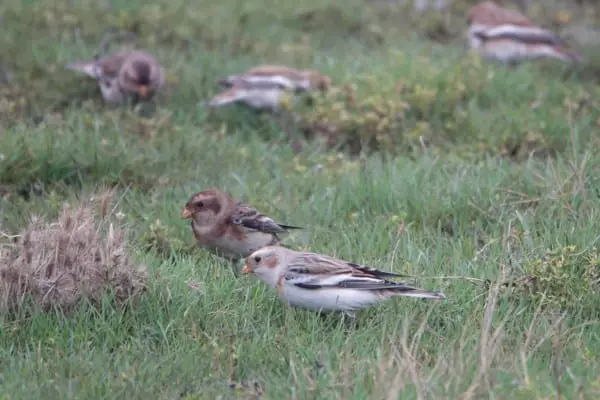
Snow Buntings exhibit a range of behaviors that are characteristic of their species. They are highly social birds, often gathering in large flocks, particularly during the non-breeding season.
Flocking provides them with protection, better foraging efficiency, and social interactions. During the breeding season, male Snow Buntings engage in impressive flight displays, soaring high in the air while singing and performing intricate wing movements to attract females and establish territories.
Snow Buntings are primarily ground foragers, hopping, walking, and running on the ground in search of seeds, insects, and small invertebrates. They have stout bills that they use to probe the ground and vegetation for food. Their diet consists of a variety of seeds, insects, and vegetation, depending on the availability of resources in their environment.
Vocalizations play a significant role in Snow Bunting communication. They have a repertoire of calls, including melodic chirps, trills, and twitters, which are used during flight, in flock interactions, and for establishing territories. Males also sing to attract mates and defend their breeding territories.
Snow Buntings are known for their remarkable long-distance migrations. They travel from their arctic breeding grounds to wintering areas in more temperate regions, often forming migratory flocks during their journeys. Their ability to undertake extensive migrations is crucial for finding suitable food and habitat during different seasons.
Habitat
Snow Buntings breed in the Arctic and subarctic regions of the Northern Hemisphere, including tundra areas, rocky slopes, and coastal plains. They are typically found in open habitats such as meadows, grasslands, and coastal dunes.
During the breeding season, they prefer nesting in areas with sparse vegetation, rocky outcrops, or low-lying shrubs, which provide some shelter and protection for their nests. These nesting habitats are often found in or near open tundra or coastal areas.
In their wintering grounds, Snow Buntings occupy a broader range of habitats. They can be found in agricultural fields, coastal marshes, beaches, dunes, and grassy areas. They are particularly attracted to areas with abundant seed resources and open spaces for foraging.
Range
Snow Buntings are primarily arctic-breeding birds that have a circumpolar distribution across the Northern Hemisphere. While they are not native to Hawaii, the Northwestern Hawaiian Islands have recorded a surprising number of Snow Buntings as winter vagrants, representing the southernmost range for this species. These vagrant individuals have been observed on islands such as Kure, Midway, and French Frigate.
Conservation Status
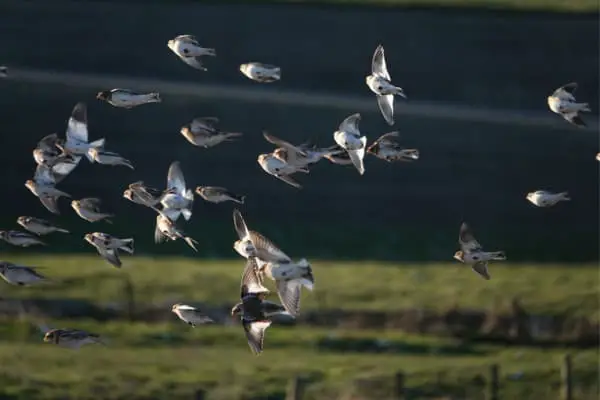
The Snow Bunting is currently listed as a species of “Least Concern” by the International Union for Conservation of Nature (IUCN). This designation suggests that the species has a large global population and is not facing immediate threats or significant population declines.
Snow Buntings have a wide distribution across the Arctic and subarctic regions of the Northern Hemisphere. Their populations are generally stable, and they have shown the ability to adapt to changing environmental conditions.
Interesting Facts
1. Seasonal color change
Snow Buntings undergo a striking plumage change between seasons. During the breeding season, males display a bright white plumage with black wingtips, while in winter, both males and females molt into a mostly brownish-gray plumage.
2. Arctic specialists
Snow Buntings are highly adapted to cold environments, with specialized adaptations like thick plumage, feathered legs, and a unique metabolic system that allows them to withstand low temperatures.
3. Vocal performers
Male Snow Buntings have a melodious song that they use to defend territories and attract mates. Their song consists of a series of high-pitched notes, trills, and musical phrases
4. Sociable flocks
Snow Buntings are highly social birds and often gather in large flocks, especially during the non-breeding season. These flocks provide safety, cooperative foraging, and social interactions.
Frequently Asked Questions
1. How do Snow Buntings survive in the Arctic’s extreme cold?
Snow Buntings have several adaptations to survive in the cold Arctic environment. They possess a thick plumage that provides insulation, feathered legs for added warmth, and a unique metabolic system that allows them to regulate body temperature and conserve energy.
2. How long do Snow Buntings live?
Snow Buntings have an average lifespan of around 3 to 5 years in the wild. However, some individuals can live longer, with the maximum recorded lifespan being around 9 years.
3. Do Snow Buntings have any predators?
Snow Buntings face predation threats from various predators in their breeding and wintering habitats. Common predators include birds of prey such as falcons, owls, and hawks, as well as mammals like foxes, weasels, and domestic cats.
